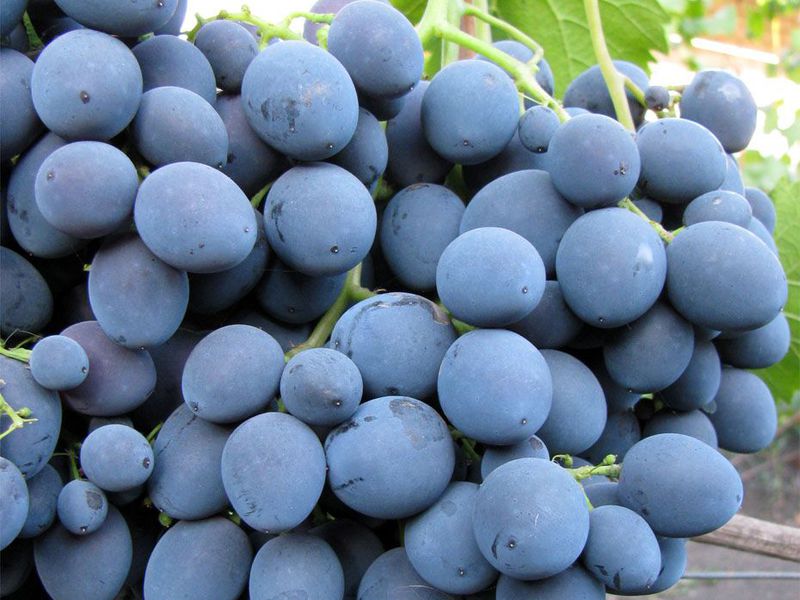
Grapes of Strashinsky variety are distinguished by impressive indicators of yield and size of berries. One cannot fail to note the great attractiveness of clusters, however, the reviews of gardeners working with it are mixed. The yield indicated in the description of the variety is quite true, but the grapes found many other shortcomings. It remains to be reconciled with some of them, but most of the problems associated with cultivating the variety are solved by proper agricultural technology.
Content
Grade description
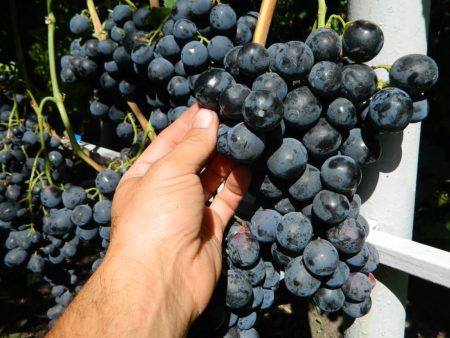
The hybrid Strascheni grape variety, also known as “Consul”, comes from Moldova, where in the 80s Zhuravlev, M.S., Borzikova G.M., Gavrilov I.P. and other specialists of the local research institute. The list of parents of the hybrid is represented by varieties Muscat de Saint-Valle, Druzhba, 20-473, Dodrelaby, Save Saillard, Catta Kurgan.
In Russia, the variety is available for cultivation only in the southern regions due to insufficient frost resistance and a medium-late ripening period. Berries are ready to harvest on 130-145 days from the beginning of the vegetative period, which is due to the long flowering period.
Structural features
Strashensky grape bushes are vigorous, with a powerful trunk and branches. Vines grow up to 2 m. 3-4 inflorescences appear on the shoot, among which there are both male and female flowers, therefore pollinators are not required for grapes.
The weight of clusters, on average, ranges from 800 to 1.5 kg, but often 2.5 kg. Bunches of medium density, elongated, cylindrical or cylindrical, the largest specimens reach 50 cm in length. The usual sizes of clusters weighing about 1-1.5 kg are 28-30 cm long and 14-16 cm wide.
Characteristics of berries
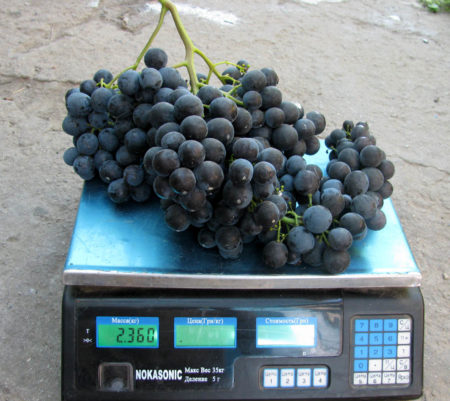
Fruits are round in shape, very large - about 3 cm long and 2.8 cm wide. Unripe berries have a dark purple color, which becomes almost black in ripe fruits.
The peel is very tender, because of which the fruits are not subject to prolonged transportation and do not differ in keeping quality.
The berries are covered with a wax coating. The pulp is simultaneously fleshy and juicy. The concentration of sugars in the fruit is 18-19%, the acid content is 7-8 g / l. A variety of table setting, berries can be eaten fresh or used to make jam and jams. The taste was rated at 8 points on a tasting scale.
Bushes of the Strashinsky cultivar enter fruiting at the age of 2 years. Harvesting adult grapes gives a record - about 1 kg of vineyard ripens about 2.5 kg of fruit.
Bush indicators:
- one plant gives 30 kg of berries;
- the mass of the fetus is 8-14 g;
- on one vine, on average, 2 clusters can mature qualitatively.
Sustainability indicators
Resistance of Strashinsky grapes to adverse conditions is not the best, which is in most cases the reason for refusing to cultivate the variety.
- The winter hardiness of grapes is weak - the vines can withstand temperatures up to -17 ° C. The bush may not be affected at temperatures up to -24 ° C, but only if the cooling is short.
- Strashensky cannot be called drought-resistant grapes.
- The variety is susceptible to oidium (4 points), tolerant to mildew (3 points), but sufficiently resistant to rot disease (2 points).
- Ripening berries attract many wasps.But insects begin to swarm over grape bushes not earlier than the second half of August, since the process of accumulation of sugars in fruits proceeds slowly.
- On the bushes of Strashensky there is almost no spider mite and grape aphid.
Advantages and disadvantages of the variety
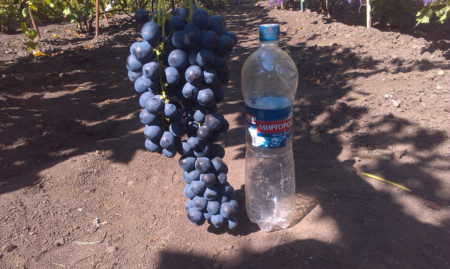
Gardeners differ in their assessment of the taste of Strashensky grapes: some consider it simple, inexpressive, while others consider it rather pleasant. Regarding other advantages and disadvantages, opinions coincide.
Among the positive aspects note:
- high productivity;
- large size of berries;
- magnificent appearance of bunches and fruits;
- non-susceptibility to the most common attacks grape pests;
- good survival of cuttings.
The disadvantages of the variety:
- poor resistance to climatic factors;
- long ripening period, which makes cultivation impossible in most regions;
- short shelf life of fruits;
- poor transportability;
- insufficiently high, in general, resistance to diseases;
- uneven ripening of bunches.
Features of agricultural technology varieties
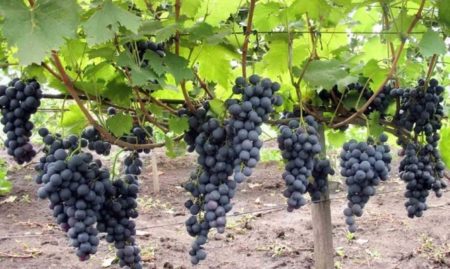
When growing Strashensky grapes, special attention should be paid to such aspects of care as:
- disease prevention;
- bush pruning;
- normalization;
- shelter for the winter.
The rest of the variety requires conventional agricultural technology, but for a good harvest, care for the bushes should be done carefully. Grapes should get all planned top dressing, since a large volume of fruits takes up a lot of resource, and in dry periods, irrigation is very important, since the plant reacts poorly to moisture deficiency.
Disease Prevention and Shelter
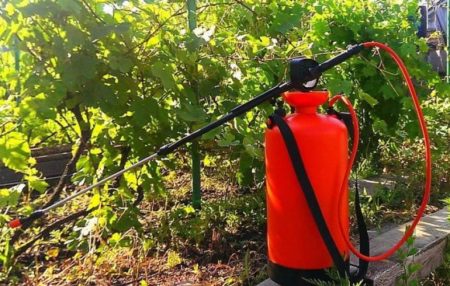
Disease prevention oidium or mildew requires at least 3-4 treatments with fungicides per season, the first of which should be carried out immediately after cleaning the shelter, and the last 4 weeks before collection the harvest. It is also important to remove weed vegetation around the bushes, fake leaves and conduct autumn digging of the soil.
Strashensky does not apply to varieties in which case shelter can be neglected even when grown in the south. The level of protection is determined by the average winter temperatures inherent in the region, the abundance of snow, the likelihood of thaws. When organizing shelter, it is important to minimize the risk of developing fungi under cover, the probability of which is high in mild winters. The worst option in this sense is a film, the grapes are least susceptible to fungus, if spruce or pine branches are used as mulch.
Trimming and rationing the bush
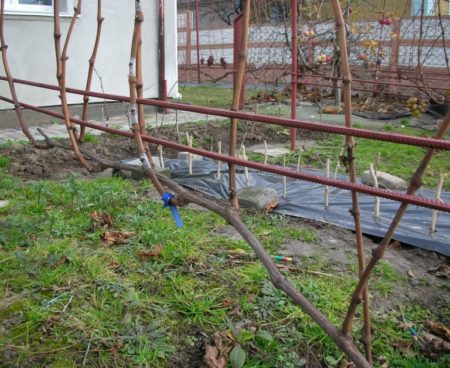
Pruning vines need to be carried out on 4-6 kidneys. In general, 40-60 eyes should be left on the vine bush. The exact figure determines the region of cultivation - the closer to the north, the fewer eyes should be kept.
To nourish an impressive volume of fruits, the processes of plant photosynthesis must proceed intensively, and this is impossible without a dense deciduous cover on the bush. In view of this, when trimming, it is recommended to leave more stepsons. To stimulate the appearance of secondary shoots, the fruit vine at the initial stage of development should be pinched. Since no fruits are formed on the stepsons of the Strashinsky variety, this is the best measure to increase the foliage of the bush.
Tips for improving the quality of bunches and grapes:
- It is worth removing the first flowering brush on the bush. This technique reduces the flowering time, respectively, the fruits also ripen earlier than usual.
- During the formation of the ovaries, grape brushes should be pinched, removing a third of their length. In such a bunch, all the berries will ripen together, although it will be smaller.
- When the fruits begin to ripen, you need to normalize the bunches to reduce the load on the vines and accelerate the ripening of the remaining berries. On one vine should leave up to 1.2 kg of bunches.
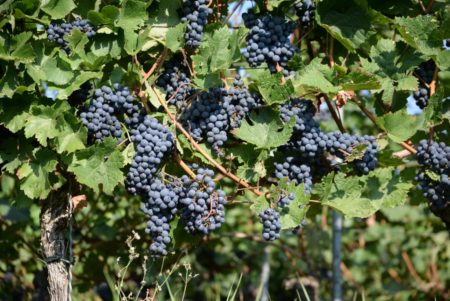
Gardeners reviews
Maria, 43 years old
“The variety is not“ cottage ”is suitable only for growing constantly near the place of residence, because oversight in care will immediately affect the quality of the berries - either ripen unevenly, or the color will be uneven, or the taste will be sour. When I just started growing this variety, many berries cracked, as I found out later, this happens in wet summers if the clusters are close to the ground. Now I just lift them higher. But grapes are easy to propagate, cuttings root well. But I still recommend seedlings, they win in terms of survival. "
Boris, 47 years old
“Four bushes of Strashensky are growing, but I haven’t found any application for him, so I don’t plan to increase their number. Yes, the harvest is impressive, but the taste is boring for me. For sale? Very beautiful clusters, but the berries quickly deteriorate. It remains to make jam, stewed fruit, juice from them, for these needs there are more berries than required. ”
Elizabeth, 54
“Strashensky is extremely susceptible to fungus. The sad experience makes me now spray even the seedlings almost immediately after being placed in the pit. But the clusters are really good, the berries are large, when buying the first bush, I could not even believe that this was possible. Yes, and the bush itself is powerful, so when planting between the bushes you need to retreat at least 2.5 m, and do the row spacing of 3 m, otherwise the roots will begin to "fight" for moisture and nutrition. Grapes noticeably respond to drought, I think, on the sandy ground with him one torment. "
Alexander, 50 years old
“We cultivate Strashensky in the Volga region, and the crop has time to ripen, if not overload the vines. Personally, I achieved ripening from him only when I began to leave about 20 eyes in the whole bush. ”
Strashensky can not be called unpretentious grapes, but, in the case of a small planting, the ratio of crop / labor costs speaks in favor of cultivating the variety. Two or three bushes are not too burdensome to carebut will provide a large volume of berries. For larger vineyards, the profitability of the variety is doubtful. Despite the decorative clusters, commercial cultivation is meaningless due to the inability to transport berries.




 Non-covering winter-hardy grape varieties for Moscow region
Non-covering winter-hardy grape varieties for Moscow region How to keep the vine in winter
How to keep the vine in winter When can I transfer grapes to another place in the fall
When can I transfer grapes to another place in the fall How to cover and prepare grapes for the winter in the suburbs
How to cover and prepare grapes for the winter in the suburbs